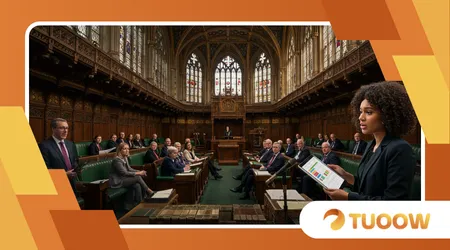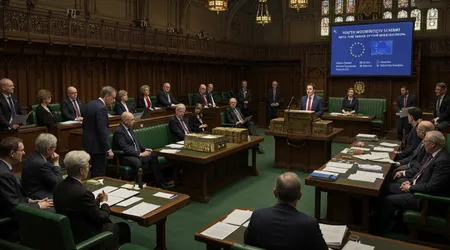House of Lords Debates Youth Mobility Scheme with European Union

The House of Lords debates youth mobility scheme proposals signal a pivotal moment for UK-EU relations, offering young Britons a chance to reconnect with Europe post-Brexit.
Amid strained ties since the 2016 referendum, this initiative could bridge cultural and economic gaps.
With Prime Minister Keir Starmer pushing for a “reset” in relations, the scheme targets 18- to 30-year-olds, enabling them to live, work, and study abroad for up to two years. But why now?
The urgency stems from a need to bolster soft power, counter economic stagnation, and respond to youth demands for global opportunities.
This article dives into the debate’s implications, exploring its potential to reshape education, cultural exchange, and economic growth while addressing political sensitivities.
The House of Lords debates youth mobility scheme discussions come at a time when public support for closer EU ties is growing, particularly among younger generations.
A 2024 YouGov poll found 67% of 18- to 24-year-olds favor reinstating some form of mobility with Europe.
Yet, the government treads carefully, wary of reigniting Brexit divisions. Labour’s manifesto firmly rejects returning to freedom of movement, framing the scheme as a distinct, reciprocal exchange.
This nuanced approach seeks to balance domestic skepticism with the undeniable benefits of cross-border collaboration.
Let’s unpack the debate’s core issues, its educational impact, and the challenges ahead.
Educational Opportunities Through Mobility
Imagine a young Briton, Sophie, studying marine biology in Lisbon, collaborating with EU peers on climate research.
The House of Lords debates youth mobility scheme spotlight such possibilities, emphasizing access to Europe’s top universities.
Unlike the Erasmus program, which the UK left post-Brexit, this scheme could offer broader, reciprocal access for thousands.
It’s not just about academics; it’s about cultural fluency and global networks.
The loss of Erasmus hit hard UK student participation in EU exchanges dropped by 50% from 2019 to 2023.
A new scheme could reverse this, fostering skills like adaptability and multilingualism. Universities UK has urged ministers to prioritize mobility, citing its role in preparing graduates for global markets.
The House of Lords debates youth mobility scheme underscore this, with peers like Lord Bilimoria advocating for educational bridges.
++ How to Transfer from a University Abroad to a UK University
Yet, logistical hurdles loom. Visa costs, capped at £10-£16 under the UK’s Electronic Travel Authorisation (ETA) system, could deter low-income students.
The Lords are pushing for subsidies to ensure inclusivity, learning from Australia’s mobility model. Can a scheme truly democratize opportunity without bold funding?

Economic and Cultural Dividends
Picture a young chef, Tom, honing his craft in Bologna, bringing Italian techniques back to his London restaurant.
The House of Lords debates youth mobility scheme highlight such economic ripple effects. By exposing youth to diverse markets, the scheme could boost UK exports and innovation.
The European Movement UK estimates it could add £2.5 billion annually to the economy through tourism and trade.
Culturally, the scheme promises to rebuild bridges. Young Britons, isolated by Brexit, crave European connections think music festivals, art residencies, or tech startups.
The House of Lords debates youth mobility scheme stress mutual enrichment, with Germany’s ambassador, Miguel Berger, calling it a “win-win.” But critics fear it could strain public services if not capped.
Also read: The UK’s Student Loan System Explained: What You’ll Owe
The “one in, one out” model, limiting visas to 500-1,000 annually per country, aims to address this. Similar schemes with Canada and Australia show manageable migration flows.
Still, peers like Baroness Wheatcroft warn against over-restriction, urging flexibility to maximize benefits. Will caps stifle the scheme’s potential?
Political Sensitivities and Brexit’s Shadow
Brexit’s scars run deep, and the House of Lords debates youth mobility scheme navigate a political minefield. Labour insists this isn’t freedom of movement, but hardline Brexiteers remain skeptical.
In the Commons, MP Lee Anderson warned it could “open the floodgates.” The Lords, however, argue it’s a pragmatic step, not a reversal of Brexit.
Public sentiment is shifting 62 Labour MPs signed a 2024 letter backing the scheme, reflecting backbench pressure.
The House of Lords debates youth mobility scheme also reveal cross-party support, with Liberal Democrats like Baroness Ludford championing youth opportunity.
Yet, ministers like Nick Thomas-Symonds have downplayed plans, citing manifesto pledges.
The EU’s push for a four-year scheme clashes with the UK’s preference for 12-24 months.
Negotiations, intensified after Starmer’s April 2025 meeting with Ursula von der Leyen, hinge on compromise. Could a middle ground, like a two-year cap, satisfy both sides?
Challenges and Implementation
Rolling out a mobility scheme isn’t simple logistics, funding, and reciprocity demand precision. The House of Lords debates youth mobility scheme highlight visa processing as a bottleneck.
The ETA system, mandatory for Europeans since April 2025, needs streamlining to handle thousands of applications. Peers suggest a dedicated youth visa portal.
Funding is another hurdle. The Turing scheme, Erasmus’s replacement, has been criticized for underfunding only 20% of applicants secured placements in 2024.
Lords like Lord Storey propose ring-fenced budgets to avoid repeating this. Without investment, the scheme risks excluding disadvantaged youth.
Reciprocity is key the EU demands equal access for its youth. The Lords stress mutual benefits, citing Canada’s model, where 2,000 visas are exchanged annually.
But what if EU states impose stricter caps?
The House of Lords debates youth mobility scheme urge robust diplomacy to ensure fairness.
A Vision for the Future
The scheme could redefine UK youth’s place in the world, fostering global citizens.
Imagine Sophie presenting her Lisbon research at a UN conference, or Tom’s restaurant sparking a UK-Italian food trend.
The House of Lords debates youth mobility scheme envision this legacy, with peers like Baroness Young emphasizing long-term soft power.
Yet, success hinges on public buy-in. Pro-Brexit areas show surprising support 55% of Red Wall voters back mobility, per a 2025 BMG Research poll.
Communicating the scheme as a post-Brexit win, not a retreat, is crucial. The Lords advocate framing it as empowerment, not concession.
Engagement starts now. Why shouldn’t young Britons seize the same opportunities as their Australian or Canadian peers?
The House of Lords debates youth mobility scheme call for bold action, urging ministers to act before the May 2025 UK-EU summit. The clock is ticking.
Table: Comparing Youth Mobility Schemes
| Country | Visa Duration | Annual Cap | Age Range | Key Benefit |
|---|---|---|---|---|
| UK-EU (Proposed) | 12-24 months | 500-1,000 per country | 18-30 | Educational and cultural exchange |
| UK-Australia | 2 years | 35,000 | 18-35 | Work and travel flexibility |
| UK-Canada | 2 years | 2,000 | 18-30 | Reciprocal professional growth |
Conclusion: A Bridge to Opportunity
The House of Lords debates youth mobility scheme mark a turning point, offering a lifeline for UK youth stifled by Brexit’s fallout.
This isn’t about reversing the past but building a future where young Britons thrive globally.
From classrooms in Berlin to kitchens in Barcelona, the scheme promises to weave a tapestry of opportunity, innovation, and connection.
Despite political tightropes and logistical challenges, the Lords’ vision is clear: empower the next generation.
As negotiations unfold, the stakes are high will the UK seize this chance to redefine its place in Europe?
The May 2025 summit looms, and with it, a defining moment for education and beyond.
FAQs
What is the youth mobility scheme?
It’s a proposed visa program allowing 18- to 30-year-olds from the UK and EU to live, work, and study abroad for up to two years.
How does it differ from freedom of movement?
Unlike freedom of movement, it’s capped, time-limited, and reciprocal, focusing on youth exchange, not unrestricted migration.
When will the scheme be implemented?
No firm timeline exists, but discussions aim for agreement by the May 2025 UK-EU summit.
Who supports the scheme?
Over 60 Labour MPs, Liberal Democrats, and peers like Lord Bilimoria back it, alongside Germany’s ambassador and EU negotiators.
